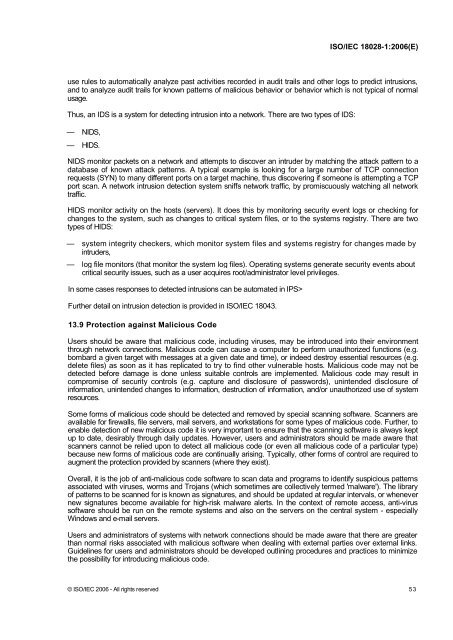INTERNATIONAL ISO/IEC STANDARD 18028-1
INTERNATIONAL ISO/IEC STANDARD 18028-1
INTERNATIONAL ISO/IEC STANDARD 18028-1
- No tags were found...
Create successful ePaper yourself
Turn your PDF publications into a flip-book with our unique Google optimized e-Paper software.
<strong>ISO</strong>/<strong>IEC</strong> <strong>18028</strong>-1:2006(E)use rules to automatically analyze past activities recorded in audit trails and other logs to predict intrusions,and to analyze audit trails for known patterns of malicious behavior or behavior which is not typical of normalusage.Thus, an IDS is a system for detecting intrusion into a network. There are two types of IDS:— NIDS,— HIDS.NIDS monitor packets on a network and attempts to discover an intruder by matching the attack pattern to adatabase of known attack patterns. A typical example is looking for a large number of TCP connectionrequests (SYN) to many different ports on a target machine, thus discovering if someone is attempting a TCPport scan. A network intrusion detection system sniffs network traffic, by promiscuously watching all networktraffic.HIDS monitor activity on the hosts (servers). It does this by monitoring security event logs or checking forchanges to the system, such as changes to critical system files, or to the systems registry. There are twotypes of HIDS:— system integrity checkers, which monitor system files and systems registry for changes made byintruders,— log file monitors (that monitor the system log files). Operating systems generate security events aboutcritical security issues, such as a user acquires root/administrator level privileges.In some cases responses to detected intrusions can be automated in IPS>Further detail on intrusion detection is provided in <strong>ISO</strong>/<strong>IEC</strong> 18043.13.9 Protection against Malicious CodeUsers should be aware that malicious code, including viruses, may be introduced into their environmentthrough network connections. Malicious code can cause a computer to perform unauthorized functions (e.g.bombard a given target with messages at a given date and time), or indeed destroy essential resources (e.g.delete files) as soon as it has replicated to try to find other vulnerable hosts. Malicious code may not bedetected before damage is done unless suitable controls are implemented. Malicious code may result incompromise of security controls (e.g. capture and disclosure of passwords), unintended disclosure ofinformation, unintended changes to information, destruction of information, and/or unauthorized use of systemresources.Some forms of malicious code should be detected and removed by special scanning software. Scanners areavailable for firewalls, file servers, mail servers, and workstations for some types of malicious code. Further, toenable detection of new malicious code it is very important to ensure that the scanning software is always keptup to date, desirably through daily updates. However, users and administrators should be made aware thatscanners cannot be relied upon to detect all malicious code (or even all malicious code of a particular type)because new forms of malicious code are continually arising. Typically, other forms of control are required toaugment the protection provided by scanners (where they exist).Overall, it is the job of anti-malicious code software to scan data and programs to identify suspicious patternsassociated with viruses, worms and Trojans (which sometimes are collectively termed 'malware'). The libraryof patterns to be scanned for is known as signatures, and should be updated at regular intervals, or whenevernew signatures become available for high-risk malware alerts. In the context of remote access, anti-virussoftware should be run on the remote systems and also on the servers on the central system - especiallyWindows and e-mail servers.Users and administrators of systems with network connections should be made aware that there are greaterthan normal risks associated with malicious software when dealing with external parties over external links.Guidelines for users and administrators should be developed outlining procedures and practices to minimizethe possibility for introducing malicious code.© <strong>ISO</strong>/<strong>IEC</strong> 2006 - All rights reserved 53
















